- Contents
- Editors' Note
- Acknowledgments
- Dickinson's Transplantation of Citizenship in the Earth: An Un-Silencing by Beth Staley
- “We send the Wave to find the Wave”: Dickinson’s Wave-Particle Duality by Mary Loeffelholz
- “Then quiver down, with tufts of Tune –”: Dickinson’s Palpable Soundscapes by Joan Wry
- “Buccaneers of Buzz”: Dickinson’s Humanimal Poetics by Alison Fraser
- Going to Sea in Emily Dickinson’s Poetry: Decentered Humanism and Poetic Ecology by Brian Yothers
- Coda: Natural Messages and Aesthetic Pleasure in Emily Dickinson’s Nature Writing by Grace Mei-shu Chen
“Buccaneers of Buzz”: Dickinson’s Humanimal Poetics by Alison Fraser
Dickinson’s poetic bestiary is wild, diverse, and fecund—nearly 700 of her poems (about 40%) include animals.[1] Writing during the radical reconsideration of animal life spurred by Charles Darwin’s explosive theory of evolution, and against a longstanding tradition of establishing American identity in terms of its fauna,[2] Dickinson redefined the relationship of humans to the animal world in her poetry. Her poems’ depictions of interspecies relationships, where animals and humans work for similar goals, sometimes with similar tools, are particularly revealing for their vexed and vexing depictions of the human/animal—or, in shorthand, humanimal—bonds. The humanimal poetics Dickinson develops in these poems reveals possible ways she conceived of the amalgamation of human and animal that, as with Deleuze and Guattari’s compound “becoming-animal,” does not imitate another but acts with its own beingness, a radical reversal of conventional assumptions about the human/animal connection.
The neologism “humanimal” extends the trajectory of animal studies and directly confronts the human-in-animal/animal-in-human. The term has been in circulation since at least 1997, but has seen more recent employment in poet Bhanu Kapil’s humanimal [a project for future children] (2003) and scholar Kalpana Seshadri’s HumAnimal: Race, Law, Language (2012).[3] Seshadri explains that the term “can open and close the weave of power that separates and unseparates human and animal” (22). In both Kapil and Seshadri’s work, the focus is on the animal-in-human; both authors seek “to make a contribution to the philosophy of race and racism in terms of the questions raised in the studies of animality and human propriety” (Seshadri ix), answering and asking questions concerning the human condition. In Dickinson’s humanimal poetics, the focus is instead on the human-in-animal, and the questions posed concern the animal condition. Subsequently, Dickinson’s humanimal is problematic to human-focused ecologies and offers alternative possibilities to hegemonic socio-economic and intellectual systems.
One area where Dickinson’s engagement with humanimal subjects is most visible is in her poems about bees. While the bee appears as a rowdy drinking fellow in many of the poems,[4] in others, like “A little Road – not made of Man – ” (Fr. 758A) or “Bees are Black – with Gilt Surcingles –” (Fr. 1426B), the bee takes on a more complicated role, operating in a world without humans (though with their objects). Through a comparative analysis of Dickinson’s bee poems with the history of bees in America and the scientific developments of the nineteenth century, this essay shows how Dickinson reconsiders assumptions about human-centered hierarchies. Dickinson’s self-actualizing bees demonstrate new ways of understanding her conception of humanity, community, and progress.
Like the European colonists, honeybees were not native to North America, but rather emigrated over the Atlantic Ocean from Europe with their human counterparts. In addition to honey and wax, bees provided a needed metaphor for New England religious leaders eager to legitimize their nascent colonies. Employing the metaphor of the beehive in 1630, John Cotton explained to his congregation that the colonists, escaping overcrowded Europe for the New World, were acting in accordance with nature by following the bee’s example: “Nature teacheth bees to doe so, when as the hive is too full, they seek abroade for new dwellings” (102).
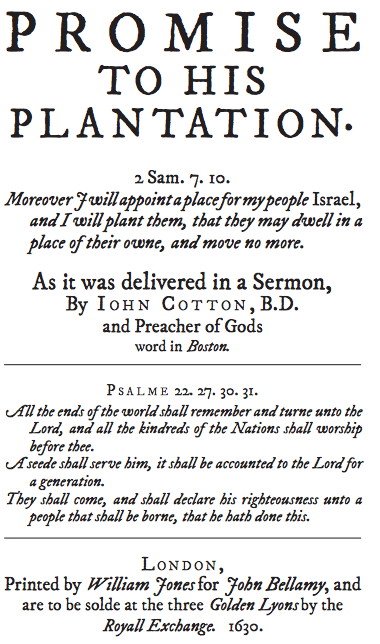
.png)
Fig. 1. Title page and excerpt from John Cotton’s “Promise to His Plantation” (1630).
Courtesy of The Mather Project, ed. Reiner Smolinski. Libraries of University of Nebraska, Lincoln. Electronic Texts in American Studies.
Although European settlers brought with them bees to colonize America, Dickinson imagines a world where the agents of colonization have become the colonizers, displacing their former masters. Taking a historical perspective, Dickinson’s depiction of a bee-centered ecology is apt; in fact, early American historian Alfred Crosby notes, “The immigrant insects did as well or better than the Europeans themselves in seventeenth century British America” (188). Like other livestock, bees were brought to America by the colonists to replicate European husbandry practices, and were first imported in 1621, along with other goods (Horn 21). However, unlike other imports, bees quickly gained autonomy from colonists, and by 1785 Thomas Jefferson noted, “The bees have generally extended themselves into the country, a little in advance of the white settlers. The Indians therefore call them the white man’s fly, and consider their approach as indicating the approach of the settlements of the whites” (77). In Jefferson’s account, the bees’ historical agency is preserved. By being unable to name a date, place, or person who brought them from Europe, Jefferson implies that the bees’ voyage, procuring passage overseas and engaging in the biggest hiving off event of their species, was as deliberate as the human settlers’.
While early settlers and European observers cast the bee as a model of colonization for humans to emulate, Dickinson instead argues that we cannot follow the bees’ example, since we cannot fully access hive life. For example, “A little Road – not made of Man – ” describes the transportation system of a bee community, inaccessible to humans but made with their objects:
A little Road – not made of Man –
Enabled of the Eye –
Accessible to Thill of Bee –
Or Cart of Butterfly –
If Town it have – beyond itself –
’Tis that – I cannot say –
I only know – no Curricle that rumble there
Bear me – (Fr. 758A /MS H50, about late 1863)
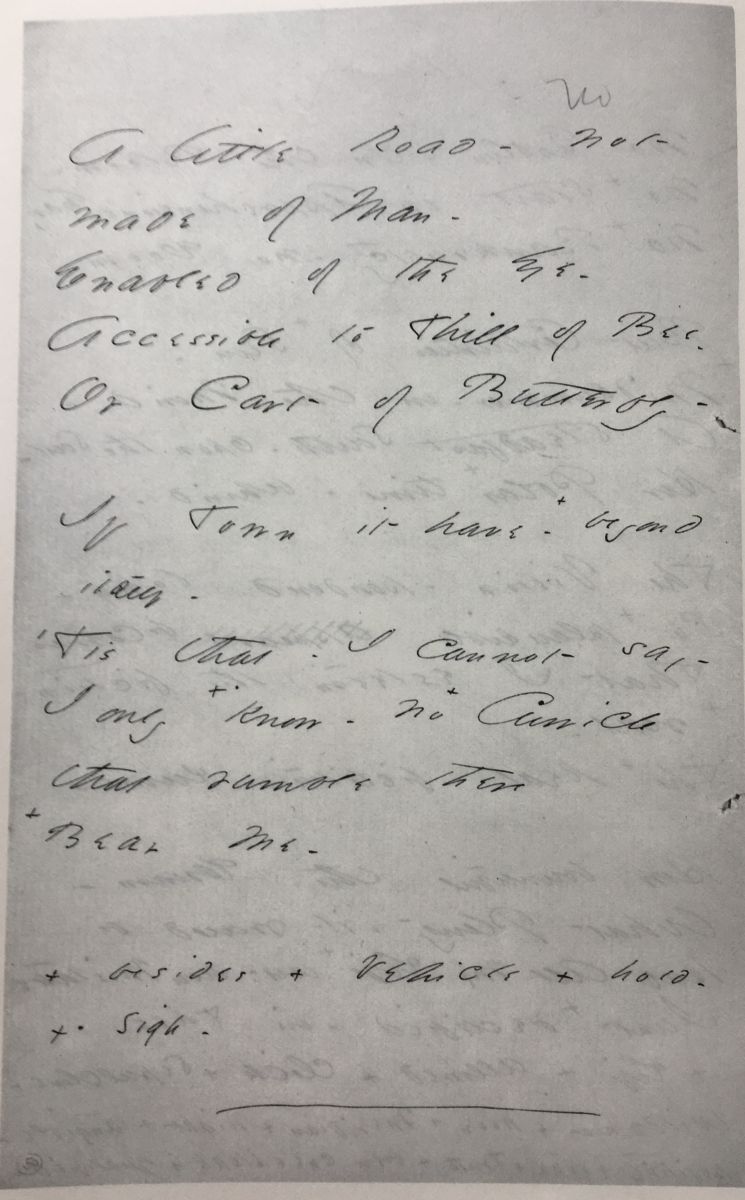
Fig. 2. H 50, “A little Road – not,” about late 1863.
Courtesy of The Houghton Library, Harvard University.
The language used to describe the bees’ community is firmly couched in human technological terms, organized around the social system of the “Town”: the “little Road” is navigated by those employing a “Thill” or “Cart.” However, these objects, including the “Curricle,” a light carriage, cannot “Bear” humans despite their human design. The bees’ road is one we literally cannot follow.
Dickinson’s depiction of bee society in human terms in “A little Road –” is an example of her humanimal poetics, or what Deleuze and Guattari would call the “becoming-animal.” By displacing humans but retaining their bee-ness, Dickinson’s bees are “not content to proceed by resemblance” (255), as Deleuze and Guattari characterize the becoming-animal, and instead retain qualities of both. Fittingly, Dickinson’s grammar is indistinct, straddling both possibilities: the “Thill of Bee –” and “Cart of Butterfly – ” can be read to mean both that the bee owns the thill, or device used to attach a carriage to an animal, or the bee is the animal who pulls the thill. Either way, bees are not laboring for humans, who are deliberately excluded, but for themselves. Imaging an alternative colony, Dickinson shifts the American tradition of bee colonist rhetoric from a metaphor used to justify European expansion to a literal humanimal serving itself and no other.
Dickinson’s understanding of human exclusion from this world populated and run by bees suggests a posthuman or “naturecultur[al]” (Harraway 25) world, anticipating arguments by twenty-first century scholars like Katherine Hayles and Donna Harraway. “A little Road –,” then, is significant in this regard not because it imagines a world of animals apart from humans alone, but because this world includes human technology and yet excludes humans. Here, technology and the organic have begun to meld, but humans—so often at the center of posthuman cybernetic discourses—are irrelevant to technology’s development and maintenance.
At the same time, Dickinson’s humanimal explorations are emblematic of contemporary concerns, as the nineteenth-century scientific community scrambled to reconsider human-centered hierarchies and the animal world after the Darwinian revolution. Joan Kirkby points out that “scientific speculation and the new epithet ‘darwinism’ were two of the central preoccupations of the periodicals in Dickinson’s lifetime” (9), particularly between 1859 and 1873, during the height of her poetic output. Radically, Darwinism redefined ecologies to claim that humans are a part of—but not apart from—other animals: a claim that appealed to Dickinson’s humanimal poetics.
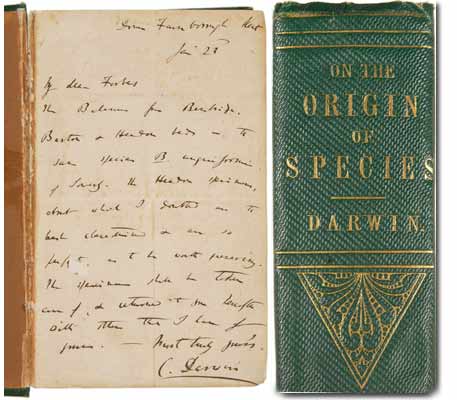
Fig. 3. First-edition copy of Charles Darwin’s The Origins of Species (1859), with an ALS by Darwin on the inside front cover.
Courtesy of Florida State University Special Collections.
One of the centerpiece examples of natural selection in On the Origin of Species was the relationship between bee and flower. As Darwin observed, “a flower and a bee might slowly become, either simultaneously or one after the other, modified and adapted to each other in the most perfect manner”(75). Not only was the bee’s co-evolutionary relationship with flowers compelling evidence for natural selection, but Darwin further argued that bees’ ability to build complex cells in their hives was on the avant-garde of intellectual discoveries, since it “has practically anticipated the discoveries of profound mathematicians” (208). Coming to terms with Darwin’s new connection of animals to humans—in a biological and intellectual sense—was an uneasy process for many. One of the more lighthearted responses to evolution, published in Harper’s Magazine—to which the Dickinson household subscribed—was the humorous poem, “Give Us Back Our Tails,” which reads in part:
If we, as Mr. Darwin says,
From monkeys are descended
. . .
. . . Darwin, if you can, my boy,
Just give us back the tails . . . (476) (qtd. Kirkby 15)
Instead of subscribing to literary anthropomorphism, in which animals are described with human qualities, the author of “Give Us Back Our Tails” (jokingly) begs for the inverse—to regain animal qualities in humans.
Against this backdrop, it is suggestive that in “Bees are Black – with Gilt Surcingles –” (Fr. 1426B/MS H H42, about late May 1877) which describes hive life as a colonial activity, Dickinson replaces humans with bees who inhabit an alternative ecosystem that has both human and animal characteristics. Dickinson’s bees—“Buccaneers of Buzz –”—conquer the surrounding territory, suggesting that, like humans, these bees are more interested in conquest than natural instinct, since the flower—supposedly the object of their labor—is in fact so incidental that it is never named:
Bees are Black – with Gilt Surcingles –
Buccaneers of Buzz –
Ride abroad in ostentation
And subsist on Fuzz –
Fuzz ordained – not Fuzz contingent –
Marrows of the Hill.
Jugs – a Universe’s fracture
Could not jar or spill. (Fr. 1426/MS H H42; 1877)
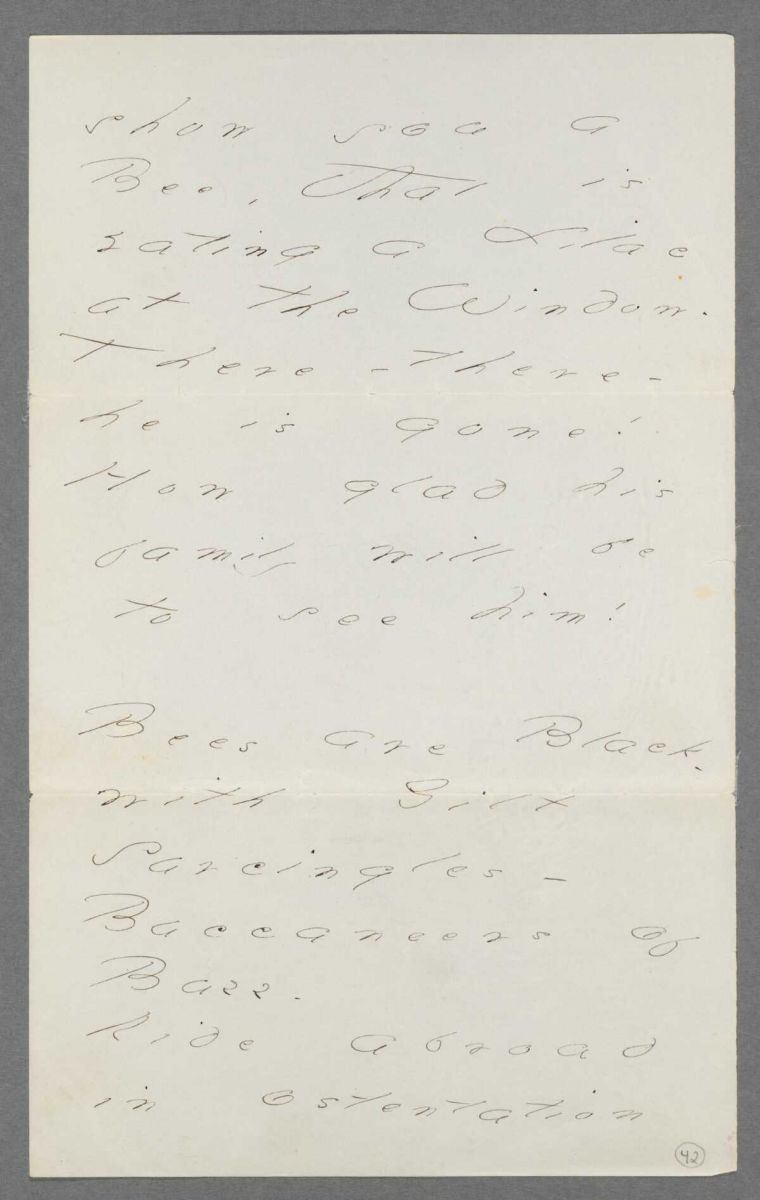
.jpg)
Fig. 4. H H42, “Bees are Black –,” about late May 1877, incorporated in a letter to Elizabeth Holland. Courtesy of The Houghton Library, Harvard University.
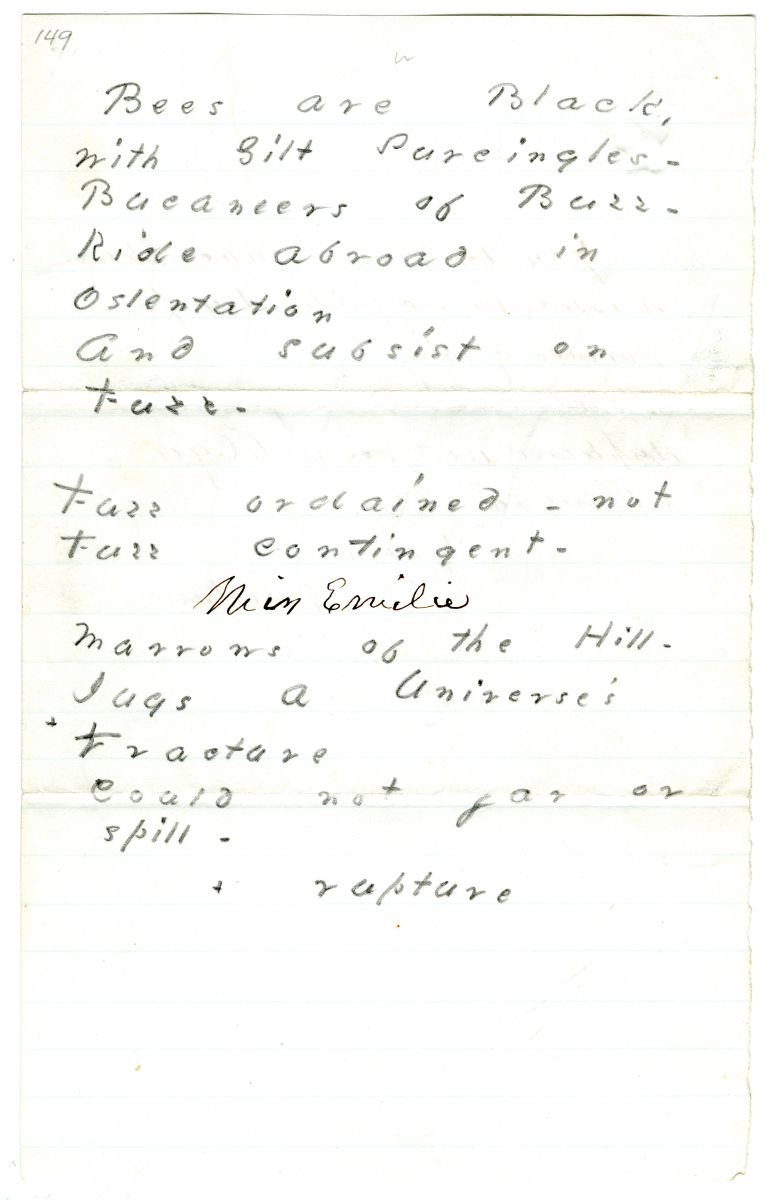
Fig. 5. AC 149, “Bees are Black,” a working draft of MS H H42, also inscribed about 1877, is extant. It appears on the back of a note addressed to “Miss Emilie” from Luke Sweetser.
Courtesy of Amherst College Archives & Special Collections.
In this poem, Dickinson depicts bees as dedicated colonizers; equipped with “Gilt Surcingles” (leather saddle straps), these “Buccaneers” conquer all in the surrounding fields. “Rid[ing] abroad,” they also echo John Cotton’s observation regarding the colonists—“when as the hive is too full, they seek abroade for new dwellings”—indicating that the bee is preoccupied with colonialist expansion rather than gathering pollen.
Since Dickinson’s bees “Ride abroad” not for unnamed flowers, but for the enjoyment of exploration and conquest, they deviate from instinctual, evolutionary bee behavior. Instead of working together as the industrious, self-supporting unit so admired by the early colonists and Darwin—and quite unlike Emerson’s “Humble-Bee,” who “See[s] only what is fair, / Sipping only what is sweet,” working in harmony with the hive—Dickinson’s bees join humanity in self-serving determinism. No longer idealized examples of nature’s perfect order and natural selection, the bees colonize, conquer, and ride abroad in carriages rather than under their own wing power—like humans, they have figured out ways to make others work for them.
While it would be tempting to read poems like “A little Road –” and “Bees are Black –” as purely metaphorical treatments of bee behavior, this would oversimplify the poems. For instance, “Bees are Black –” can be read as an example of Dickinson’s definition poems, which comprise “at least a fifth” of her poems, and “contain some of her most focused and topical thinking,” according to Jed Deppman (49). This poem fits Deppman’s definition category “surprising facts,” which comprises of poems that “announce and inform, asking and teaching us to see what we otherwise might have missed” (54). “Bees are Black –” begins with a simple fact—that bees are black—that complicates the potentially metaphorical language that follows (“with Gilt Surcingles –”), inviting the reader to understand the physical description as both literal and metaphorical. What is striking to Dickinson, as evident in her choice of metaphors, is not the bees’ unlikeness to humans but in fact their radical likeness. The pattern of using human-made objects as metaphors to describe bee life is strong enough to dismiss claims that these poems are metaphorical exercises alone. Dickinson blurs the line between metaphoric storytelling and alternative perception, demonstrating that, for the poet, these are mutually inclusive states of being. Furthermore, Dickinson’s seemingly metaphorical treatment of bee ecology becomes refocused with an examination of late-nineteenth and twentieth-century scientific developments, which claimed for bees sophisticated technologies and culture. And although Dickinson claims she “cannot say” anything about the “Town” the bees have founded in “A little Road – not made of Man – ” (Fr. 758A), her certainty in its being a center of commerce and ordered production is astute.
Twentieth-century ethologist Karl von Frisch revealed, for example, that not all in the hive are as industrious as early American rhetoricians would have their audiences believe: the male drones “are too indolent even to help themselves to their own share of the hive’s food stores, leaving it to the [female] worker-bees to feed them” (40). Not unlike the bees with “Surcingles” in “Bees are Black –,” or those with “Thill[s]” in “A little Road –,” the drones have coerced others to perform labor for them. Eventually, at the end of summer the female worker-bees banish the drones from the hive, refusing to feed them or allow them inside; either the drones starve to death on the porch of the hive or otherwise are attacked by worker-bees inside and die of their wounds. The drones’ pitiful fate is suggested in the following poem, composed about 1881 and titled “The Bumble Bee’s Religion –” when Dickinson incorporated it in a letter for her nephew Gilbert to take, along with a dead bee, to his teacher:
The Bumble Bee’s Religion –
His little Hearse like Figure
Unto itself a Dirge
To a delusive Lilac
The vanity divulge
Of Industry and Morals
And every righteous thing
For the divine Perdition
Of Idleness and Spring – (Fr. 1547/MS H B177)
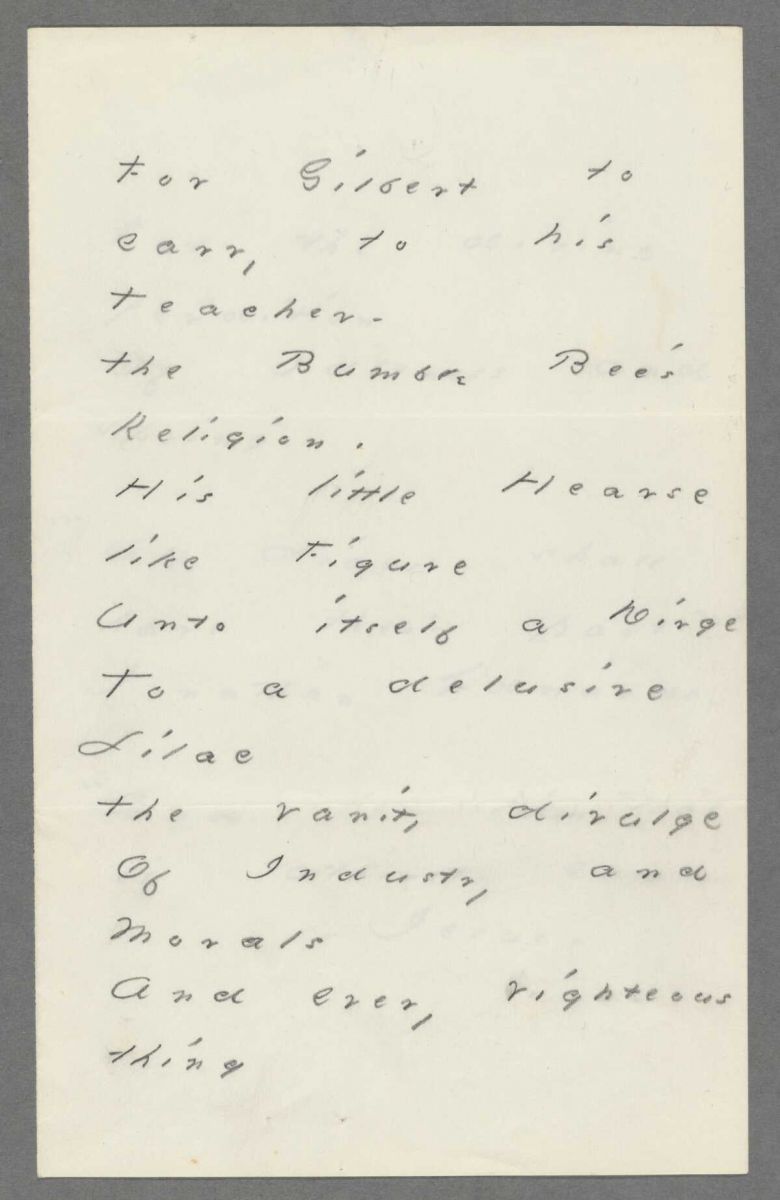
Fig. 6. H B177, “The Bumble Bee’s / Religion,” about 1881, in a note to Dickinson’s five- or six-year-old nephew, Gilbert Dickinson, to take to his teacher.
Courtesy of The Houghton Library, Harvard University.
This poem undercuts the idyllic metaphor of hive industry and community celebrated by early settlers and Darwinists, and instead outlines the imperfect society of bees, particularly as revealed by the fate of the male drone, who yearly becomes “Unto itself a Dirge,” “divulg[ing]” “The vanity . . . / Of Industry and Morals.”
Perhaps the most suggestive anticipation of von Frisch’s work in Dickinson’s bee poems centers on language. Von Frisch’s most important contribution to ethology was his decoding of the language of bees, which is tactile and olfactory rather than verbal, but nevertheless allows bees precise communication, including the ability to communicate specific varieties of flowers (120). Suitably, “Bees are Black –,” for example, reverberates with sound, in part due to the hard consonants (b, z, c, r), double letters (bees, buccaneers, buzz, fuzz, marrows), and the repetition of “Fuzz”: the poem becomes a tactile experience as these words vibrate in the mouth. Von Frisch lamented that in the hive, “a drama is being enacted worthy of the pen of one of those great classical poets who have sung the praises of the bee. But, alas! It had not been discovered during their lifetime” (114); it appears, on this count at least, he spoke too soon.
In considering Dickinson’s image of a post-human world without us, it is fitting to look to Giorgio Agamben, who argues, perhaps not incidentally, “The definitive annihilation of man in the proper sense . . . must also entail the disappearance of human language, and its substitution by mimetic or sonic signals comparable to the language of bees” (10). In Dickinson’s universe, humankind may not be annihilated, but it is supplanted by alternative expressions of social progress, technology, and community as she establishes a new ecology that does not assume the automatic supremacy of humans, but rather deconstructs humanity’s central position in the socio-biological hierarchy.
Even though we are loath to admit it, we are dependent upon a complex ecosystem to fulfill our basic needs. In the twenty-first century, the bee is employed as an itinerant farmer, shipped up and down the country to pollinate farms from Florida orange groves to Maine blueberry barrens. At the same time as humans forcefully insert themselves onto the “little Road – not made of Man –,” the bees have started disappearing, with potentially catastrophic results for both bees and humans.[5] In 2006-2007, Colony Collapse Disorder killed 30-90% of bees, and most of the possible causes are related to human activity: pesticide poisoning, changes to habitat, and stress caused by transportation. “Domestication is ordinarily understood as human control over other species,” animal studies scholar Anna Tsing writes; “That such relations might also change humans is generally ignored” (144). By focusing on the human-in-animal, Dickinson attempts to resist such temptations. Her humanimal poetics cautions that, as in the beginning of the colonization of America, the bee plays an integral part in contemporary American life.
Alison Fraser, SUNY-Buffalo
Notes
[1] According to Ferris Jabr in “How Emily Dickinson Grew Her Genius in Her Family’s Backyard,” Slate, 17 May 2016,
www.slate.com/articles/health_and_science/books/2016/05/every_single_living_creature_in_emily_dickinson_s_complete_works_cataloged.html
[2] Perhaps the most outlandish example of the latter is Thomas Jefferson’s frantic search for a moose to send to France and thus counter the popular European argument that America was a “degenerate” version of Europe (Dugatkin, Mr. Jefferson and the Giant Moose ix).
[3] Charles D. Minahen uses the terms “humanimal” and “anihumans” to describe the liminal state of being “separating humanity from animality” (233) in a 1997 article on the cartoons of Gary Larson. Most recently, poet Brenda Iijima uses the term in her poem “Humanimal Furry” (Remembering Animals 49-52).
[4] Especially “We – Bee and I – live by the quaffing – ” (Fr. 244B, 1861); see also “I taste a liquor never brewed – ” (Fr. 207B, 1861): “When ‘Landlords’ turn the drunken Bee / Out of the Foxglove’s door – ”; or “We should not mind so small a flower” (Fr. 82B, 1859): “ So drunken, reel her Bees – .” Her drunken bee poems seem a deliberate affront to Isaac Watts’ “How doth the little busy bee,” a moralizing didactic poem popular in nineteenth century children’s books, and mocked in one of Dickinson’s earliest poems, “Sic transit gloria mundi” (Fr. 2, 1852). Reimaging the cultural trope of the “busy bee” and her unceasing industry was for Dickinson a lifelong task.
[5] As the USDA admits, “Honey bees are a critical link in U.S. agricultural production. Pollination by managed honey bee colonies adds at least $15 billion to the value of U.S. agriculture annually” (np).
Works Cited
Agamben, Giorgio. The Open: Man and Animal. Stanford UP, 2003.
Cotton, John. God’s Promise to His Plantations. 1630. Edited by Louis B. Wright. Cornell UP, 1962.
Crosby, Alfred. Ecological Imperialism: The Biological Expansion of Europe, 900-1900. Cambridge UP, 1986.
Darwin, Charles. On the Origin of Species by Means of Natural Selection. 1859. New York: D. Appleton and Company, 1884.
Deleuze, Giles, and Félix Guattari. One Thousand Plateaus: Capitalism and Schizophrenia. Translated by Brian Massumi. U of Minnesota P, 1987.
Deppman, Jed. “‘I Could Not Have Defined the Change’: Rereading Dickinson’s DefinitionPoetry.” Emily Dickinson Journal, vol. 11, no. 1, 2002, pp. 49-80.
Dickinson, Emily. An Emily Dickinson Reader. Edited by R. W. Franklin. Harvard UP, 2008.
Dugatkin, Lee Alan. Mr. Jefferson and the Giant Moose: Natural History in Early America. U of Chicago P, 2009.
Harraway, Donna. When Species Meet. U of Minnesota P, 2008
Hayles, N. Katherine. How We Became Posthuman: Virtual Bodies in Cybernetics, Literature, and Informatics. U of Chicago P, 1999.
Horn, Tammy. Bees in America: How the Honey Bee Shaped a Nation. UP of Kentucky, 2006.
Jabr, Ferris. “How Emily Dickinson Grew Her Genius in Her Family’s Backyard.” Slate, 17 May 2016, www.slate.com/articles/health_and_science/books/2016/05/every_single_living_creature_in_emily_dickinson_s_complete_works_cataloged.html
Jefferson, Thomas. Notes on the State of Virginia. 1785. Boston: Lilly and Wait, 1832.
Kirkby, Joan. “‘[W]e thought Darwin had thrown “the Redeemer” away’: Darwinizing with Dickinson." Emily Dickinson Journal, vol. 19, no. 1, 2010, pp. 1-29.
Minahen, Charles D. “Humanimals and Anihumans in Gary Larson’s Gallery of the Absurd.” Animal Acts: Configuring the Human in Western History. Edited by Jennifer Ham and Matthew Senior. Routledge, 1997, pp. 231-251.
Seshadri, Kalpana Rahita. HumAnimal: Race, Law, Language. U of Minnesota P, 2012.
Smellie, William. Introduction. The Philosophy of Natural History. 5th edition. Edited by John Ware. Boston: Hilliard, Gray, and Co., 1834.
Tsing, Anna. “Unruly Edges: Mushrooms as Companion Species.” Environmental Humanities, vol. 1, no. 1, 2012, pp. 141-154.
“ARS Honey Bee Health and Colony Collapse Disorder.” USDA Agrictultural Research Service, 2015. www.ars.usda.gov/oc/br/ccd/index/
Von Frisch, Karl. The Dancing of Bees: An Account of the Life and Senses of the Honey Bee. Translated by Dora Isle and Norman Walker. Harcourt, Brace & World, 1966.
Image Credits
Fig. 1. Title page and excerpt from John Cotton’s “Promise to His Plantation” (1630). Courtesy of The Mather Project, ed. Reiner Smolinski. Libraries of University of Nebraska, Lincoln. Electronic Texts in American Studies. http://matherproject.org/sites/default/files/John_Cotton_God's_Promise.pdf (left: p. 1; right: p. 4.)
Fig. 2. H 50, “A little Road – not,” about late 1863. Courtesy of The Houghton Library, Harvard University. Digital surrogate not available.
Fig. 3. First-edition copy of Charles Darwin’s The Origins of Species (1859), with an ALS by Darwin on the inside front cover. Courtesy of Florida State University Special Collections. http://www.rinr.fsu.edu/fall2002/features/librarycollection.html
Fig. 4. H H42, “Bees are Black –,” about late May 1877, incorporated in a letter to Elizabeth Holland. Courtesy of The Houghton Library, Harvard University. For links to the digital surrogate, see: http://www.edickinson.org/editions/1/image_sets/237889 & http://www.edickinson.org/editions/1/image_sets/237890
Fig. 5. AC 149, “Bees are Black –,” a working draft of MS H H42, also inscribed about 1877, is extant. It appears on the back of a note addressed to “Miss Emilie” from Luke Sweetser. Courtesy of Amherst College Archives & Special Collections. For a link to the digital surrogate, see: https://acdc.amherst.edu/view/asc:7624
Fig. 6. H B177, “The Bumble Bee’s / Religion,” about 1881, in a note to Dickinson’s five- or six-year-old nephew, Gilbert Dickinson, to take to his teacher. Courtesy of The Houghton Library, Harvard University. For links to the digital surrogate, see: http://www.edickinson.org/editions/1/image_sets/237319 & http://www.edickinson.org/editions/1/image_sets/237320



